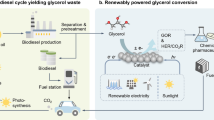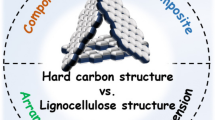Abstract
In this study, a mediator-free glucose/O2 bio-fuel cell was developed based on a 3-dimensional carbon nanomaterial/polypyrrole composite with glucose oxidase and tyrosinase as the anodic and cathodic catalysts, respectively. This mediator-free biofuel cell has the following merits: (1) the biocatalyst was unaffected by toxic mediators and (2) current generation is independent, because there is no problem associated with mediator leakage from the electrode. The carbon nanomaterial in this 3-dimensional composite was used not only as immobilization support for the biocatalyst, but also as an electron carrier. This would be advantageous for glucose oxidation on the bioanode and O2 reduction on the biocathode in the glucose/O2 biofuel cell. This biofuel cell showed enhanced power density and half-life compared to other glucose/O2 biofuel cells previously reported, producing 157.4 μW/cm3 with 1 mM glucose as fuel and 0.5 M NaCl as the electrolyte, at a cell voltage of +85 mV over 29 h with continuous 1 mM glucose feeding.
Similar content being viewed by others
References
Ieropoulos, I. A., J. Greenman, C. Melhuish, and J. Hart (2005) Comparative study of three types of microbial fuel cell. Enz. Microb. Technol. 37: 238–245.
Habrioux, A., G. Merle, K. Servat, and K. B. Kokoh (2008) Concentric glucose/O2 biofuel cell. J. Electroanal. Chem. 622: 97–102.
Arechederra, R. and S. D. Minteer (2008) Organelle-based biofuel cells: Immobilized mitochondria on carbon paper electrodes. Electrochim. Acta. 53: 6698–6703.
Kim, J., H. Jia, and P. Wang (2006) Challenges in biocatalysis for enzyme-based biofuel cells. Biotechnol. Adv. 24: 296–308.
Minteer, S. D., B. Y. Liaw, and M. J. Cooney (2007) Enzymebased biofuel cells. Curr. Opin. Biotechnol. 18: 228–234.
Topcagic, S. and S. D. Minteer (2006) Development of a membraneless ethanol/oxygen biofuel cell. Electrochim. Acta 51: 2168–2172.
Willner, I., V. Heleg-Shabtai, R. Blonder, and E. Katz (1996) Electrical wiring of glucose oxidase by reconstitution of FAD-modified monolayers assembled onto Au-electrodes. J. Am. Chem. Soc. 118: 10321–10322.
Zayats, M., E. Katz, and I. Willner (2002) Electrical contacting of flavoenzymes and NAD(P)+-dependent enzymes by reconstitution and affinity interactions on phenylboronic acid monolayers associated with Au-electrodes. J. Am. Chem. Soc. 124: 14724–14735.
Fernando Patolsky, Yossi Weizmann, and Itamar Willner (2004) Long-range electrical contacting of redox enzymes by SWCNT connectors 13. Angew. Chem. Int. Ed. 43: 2113–2117.
Liu, Y. and S. Dong (2007) A biofuel cell harvesting energy from glucose-air and fruit juice-air. Biosens. Bioelectron. 23: 593–597.
Ramanavicius, A., A. Kausaite, and A. Ramanaviciene (2008) Enzymatic biofuel cell based on anode and cathode powered by ethanol. Biosens. Bioelectron. 24: 761–766.
Shiunchin C. Wang, Fan Yang, Manuel Silva, Anna Zarow, Yubing Wang, Zafar Igbal (2009) Membrane-less and mediatorfree enzymatic biofuel cell using carbon nanotube/porous silicon electrodes. Electrochem. Comm. 11: 34–37.
Liu, Y. and S. Dong (2007) A biofuel cell with enhanced power output by grape juice. Electrochem. Comm. 9: 1423–1427.
Gao, F., Y. Yan, L. Su, L. Wang, and L. Mao (2007) An enzymatic glucose/O2 biofuel cell: Preparation, characterization, and performance in serum. Electrochem. Comm. 9: 989–996.
Brunel, L., J. Denele, K. Servat, and K. B. Kokoh (2007) Oxygen transport through laccase biocathodes for a membrane-less glucose/O2 biofuel cell. Electrochem. Comm. 9: 331–336.
Liu Deng, Li Shang, Yizhe Wang Tie Wang, Hongjun Chen, Shaojun Dong (2008) Multilayer structured carbon nanotubes/poly-l-lysine/laccase composite cathode for glucose/O2 biofuel cell. Electrochem. Comm. 10: 1012–1015.
Iijima, S. (1991) Helical microtubules of graphitic carbon. Nature 354: 56–58.
Rahul Sen, Bin Zhao, Daniel Perea, Mikhail E. Itkis, Hui Hu, James Love, Elena Bekyarova, Robert C. Hadden (2003) Electronic detection of specific protein binding using nanotube FET devices. Nano Lett. 4: 459–463.
Nadine Wong Shi Kam, Theodore C. Jessop, Paul A. Wender, and Hongjie Dai (2004) Nanotube Molecular Transporter: Internalization of Carbon Nanotube-Protein Conjugates into Mammalian Cells. J. Am. Chem. Soc. 126: 6850–6851.
Min, K. and Y. J. Yoo (2009) Amperometric detection of dopamine based on tyrosinase-SWNTs-Ppy composite electrode. Talanta. Volume 80,Issue 2, page 1007–1011.
Sato, F., M. Togo, M. K. Islam, and T. Matsue (2005) Enzymebased glucose fuel cell using Vitamin K3-immobilized polymer as an electron mediator. Electrochem. Comm. 7: 643–647.
Barriere, F., P. Kavanagh, and D. Leech (2006) A laccase-glucose oxidase biofuel cell prototype operating in a physiological buffer. Electrochim. Acta. 51: 5187–5192.
Ivnitski, D., B. Branch, P. Atanassov, and C. Apblett (2006) Glucose oxidase anode for biofuel cell based on direct electron transfer. Electrochem. Comm. 8: 1204–1210.
Shleev, S., A. Jarosz-Wilkolazka, A. Khalunina, and O. Morozova (2005) Direct electron transfer reactions of laccases from different origins on carbon electrodes. Bioelectrochemistry 67: 115–124.
Wright, D. B., D. D. Banks, J. R. Lohman, J. L. Hilsenbeck, and L. M. Gloss (2002) The effect of salts on the activity and stability of Escherichia coli and haloferax volcanii dihydrofolate reductases. J. Mol. Biol. 323: 327–344.
Bowers, E.M., L. O. Ragland, and L. D. Byers (2007) Salt effects on [beta]-glucosidase: pH-profile narrowing. Biochim. Biophys. Acta. 1774: 1500–1507.
Zebda, A., L. Renaud, M. Cretin, and F. Pichot (2009) A microfluidic glucose biofuel cell to generate micropower from enzymes at ambient temperature. Electrochem. Comm. 11: 592–595.
Zheng, W., H. M. Zhou, Y. F. Zheng, and N. Wang (2008) A comparative study on electrochemistry of laccase at two kinds of carbon nanotubes and its application for biofuel cell. Chem.Phys. Lett. 457: 381–385.
Asuri, P., S. S. Karajanagi, H. Yang, and T. J. Yim (2006) Increasing protein stability through control of the nanoscale environment. Langmuir 22: 5833–5836.
Asuri, P., S. S. Bale, R. C. Pangule, and D. A. Shah (2007) Structure, function, and stability of enzymes covalently attached to single-walled carbon nanotubes. Langmuir 23: 12318–12321.
Author information
Authors and Affiliations
Corresponding author
Rights and permissions
About this article
Cite this article
Min, K., Ryu, J.H. & Yoo, Y.J. Mediator-free glucose/O2 biofuel cell based on a 3-dimensional glucose oxidase/SWNT/polypyrrole composite electrode. Biotechnol Bioproc E 15, 371–375 (2010). https://doi.org/10.1007/s12257-009-3034-z
Received:
Accepted:
Published:
Issue Date:
DOI: https://doi.org/10.1007/s12257-009-3034-z




